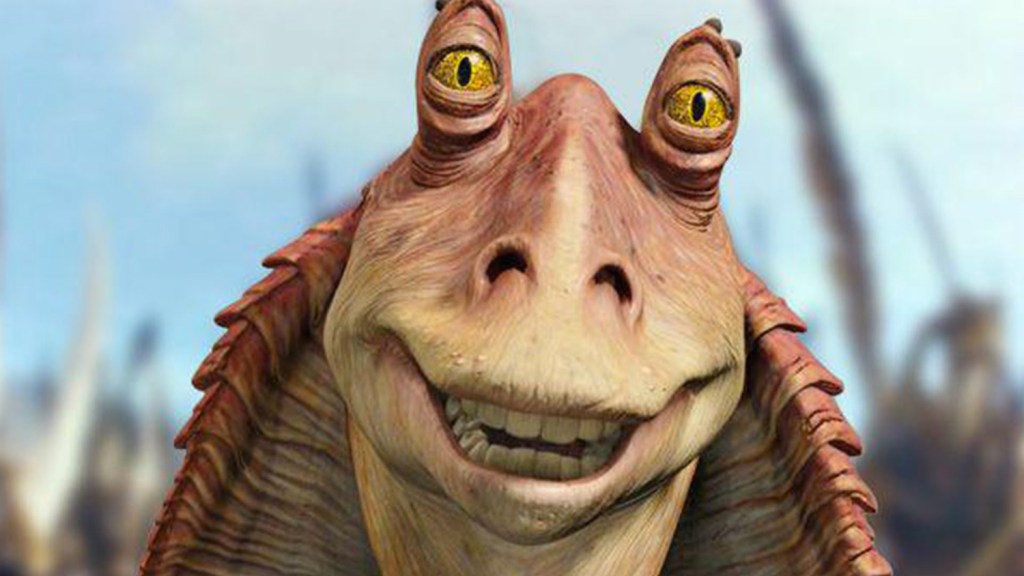If 2015’s The Force Awakens, an entertaining but imperfect film, benefited from arriving in the wake of those loathed prequels, The Phantom Menace suffered immensely for being the first Star Wars movie to be released after George Lucas’s seminal original trilogy.
Those three initial movies—1977’s Star Wars, 1980’s The Empire Strikes Back, and 1983’s Return of the Jedi—changed cinema and formed the basis of a quasi-religion for innumerable diehard fans. So in 1999—the year Lucas unleashed his long-anticipated first prequel on the public—expectations were high, and Phantom wouldn’t meet them by a long chalk. Critics were mixed, but the fans, who were hyped by promising trailers and perhaps too certain that Lucas couldn’t possibly sink lower than the Ewoks, were furious.
Videos by VICE
Since then, negative opinion of The Phantom Menace has ossified. It so disappointed so many people, in a time before sullying the memory of classic movies with unnecessary prequels was a common Hollywood practice (indeed, the very concept of the “prequel” was first popularized by Episodes I–III), that the film and its two sequels have become shorthand for cinematic betrayal. Nuance rarely enters the Phantom Menace debate these days. The prequels were, for many, tantamount to an attack on an institution, and The Phantom Menace was the unforgettable, unforgivable opening assault.
Phantom’s dire reputation, unsurprisingly, suggests something more egregious than what’s really there. Episode I can’t really be the worst prequel of all time when X-Men Origins: Wolverine, as oversized and out-of-control as Logan’s mane in that film, or The Hobbit trilogy, one of the most cynical cash-grabs in movie history, exist. Neither can Phantom be, as some claim, one of the worst movies period. There are bad films that entertainingly fail on every level, like The Room, or bad films made with high technical competence that are borderline unwatchable, like Michael Bay’s Transformers movies. The Phantom Menace fits neither category.
Of course, at script level, Phantom is a lot of bunk: Jedi knights Qui-Gon Jinn (Liam Neeson) and Obi-Wan Kenobi (Ewan McGregor) discover a precocious sprog who might be the Chosen One, Anakin Skywalker (Jake Lloyd), in the midst of an intergalactic skirmish over a trade dispute. But it’s bunk executed with earnestness and a stunning level of craftsmanship. Moreover, Episode I is a masterpiece of design. The detail in the world-building is the sort a filmmaker could only buy with a bottomless budget, and Lucas wisely doesn’t bury Phantom in special effects as per subsequent prequels, instead using CGI to complement real sets, models, and miniatures.
It means the worlds in Phantom, unlike those in the FX-cluttered and endlessly greenscreened Episodes II and III, hold up remarkably well: Naboo a verdant future Venice, its palaces inhabited by a luxuriously attired aristocracy; the Gungans’ underwater world, a hive of enormous illuminated baubles and Vernean subs; Tatooine, a parched crook’s paradise that’s home to Phantom’s podracing sequence, one of the few simple set-piece pleasures of the prequel trilogy; and Coruscant, a bustling, planet-size metropolis that’s the shining capital of the universe. These worlds are a vision of a Star Wars we’d never seen before, a look at Lucas’s galaxy far, far away before it became the faded glory of the original trilogy.
The change in aesthetic, from used-future to something more utopian, is Lucas avoiding a common prequel/sequel trap: Rather than just safely echo the originals, something which greatest-hits package The Force Awakens is guilty of, with The Phantom Menace he for better and worse forges a different path. Yes, there are midichlorians, but Lucas also turns the somewhat lumbering lightsaber duel of yore into a savage ballet, introduces a fearsome new kind of villain in iconic horned bastard Darth Maul, makes something apocalyptic of the score (one of John Williams’s best of the entire franchise), and swaps out his scrappy cowboy and scoundrel protagonists for a scrum of galactic politicians and space samurai.
Without anyone reining him in as before (prior to being an untouchable blockbuster king, Lucas had collaborators whose suggestions for changes proved crucial to the success of his films), he’s unleashed to indulge. For all its faults, Phantom is admirably not the Star Wars of old, Lucas turning his throwaway space western into a space opera that’s self-serious, fun, dull, exhilarating, embarrassing, and heartfelt all at once.
None of which excuses Jar Jar fucking Binks, the film’s coterie of overtly racist alien caricatures, or the fact that Phantom is full of dire-logue written by someone who’s seemingly never met another human being in his life and delivered as if at gunpoint by otherwise talented actors. With the exception of Ian McDiarmid, who confidently plays the scheming Senator Palpatine like this is the story of his rise to power and not Anakin’s, the cast, from Natalie Portman to an Alec Guinness–aping Ewan McGregor, are uniformly wooden. Phantom is beautiful, but so often hollow, its characters bored tourists on a journey through an overactive imagination.
But, then, one could just as easily say the same about this year’s Valerian, Luc Besson’s magnificent flop and another big, opulent mess of a sci-fi. Neither The Phantom Menace nor Valerian are so lacking in inspiration and intermittent thrills that they could really be all-time bad. Ultimately, they’re just unremarkable failures. The only difference between them is that one came with astronomical, perhaps insurmountable expectations.
Follow Brogan Morris on Twitter.




